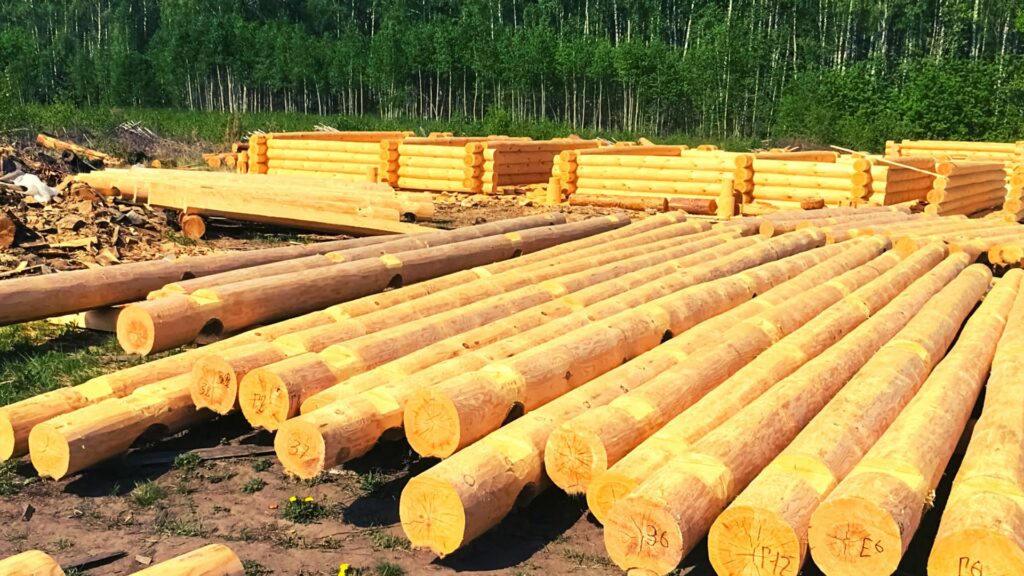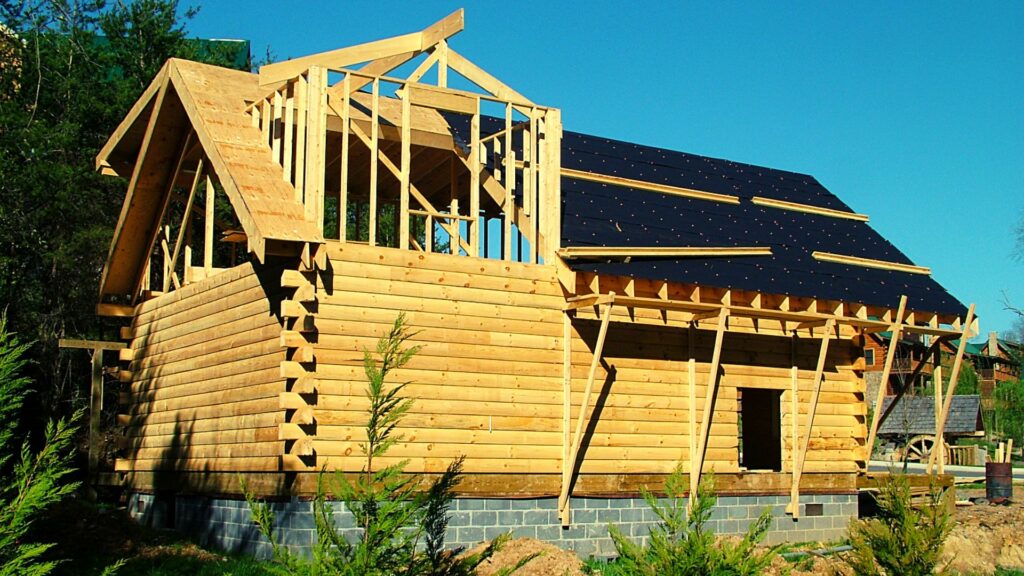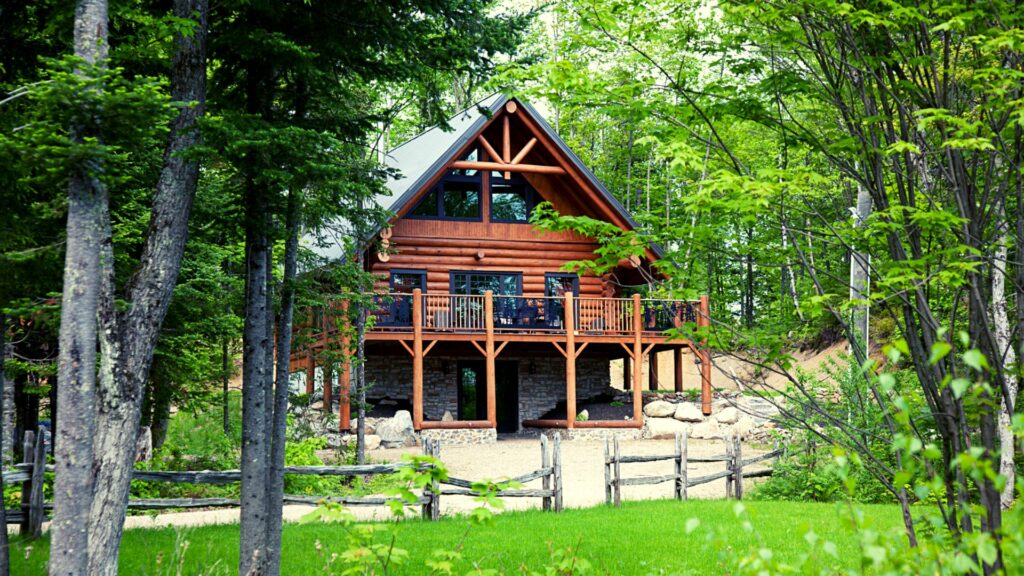The history of log construction in America can be traced back to Swedish and Finnish immigrants. The western pioneers of America did not have many options for building materials, but they needed to build shelters in the forested parts of the country, so they learned how to build log cabins.
Log construction has evolved over the centuries due to technology and machinery, but the basic principles remain the same. Today, many Americans desire to own a log cabin in the woods. Living in the woods may or may not be your dream, but a stacked log construction can be your reality.
Stacked log homes are made up entirely of logs stacked horizontally on top of each other, from the foundation to the roof. The logs provide structural support and insulation. The logs also make up the interior and exterior finish materials.
Table of Contents
What is stacked log construction?
Stacked log construction is a construction technique that involves stacking wooden logs horizontally to build a structure. End notches interlock the logs in place to create a tight arrangement that can withstand different weather seasons.
In the past, log construction was primarily used to construct schools, churches, and other commercial buildings. Today, log construction is mainly used to build elaborate homes.
Types of logs used in stacked log construction
Stacked log construction typically utilizes wooden logs that are locally available. Coniferous trees provide the best wooden logs for this construction technique due to their length. Logs should be 8-10 inches in diameter, depending on the type of log used. The most common wood species for log construction are:
- Yellow Pine
- Juniper
- Oak
- Cypress
- Alpine fir
- White and Yellow Pine
The logs can be either handcrafted or milled.
Handcrafted logs
Handcrafted logs are first cut from the forest. The barks are removed by hand using a draw-knife of water peelings method. Handcrafted logs can be airdried before using green. Handcrafted logs are not uniform in size or shape. They are fitted together on top of the other.

Milled logs
Like handcrafted logs, milled logs can be used when dry or green. The logs are cut from the forest and transported to a mill, where the bark is removed. The logs are then shaped using a lathe, planer, or sawmill. The ready logs are left green or dried. Milled logs can be kiln-dried or air-dried.
Unlike handcrafted logs, milled logs are uniform in size and shape. These logs, therefore, have a better profile. Milled logs are available as full-round, coped, or square logs.
Styles of stacked log construction
Stacked log construction is a technique that stacks wooden logs on top of each other to create walls. The logs are interlocked at the end using end notches. There are three main stacked log construction styles: chinked style, full-scribed style, full cope style, and dovetail style.
Chinked style
Chinked log construction involves stacking logs horizontally without cutting them in any way. Synthetic material called chinking fills the gaps and spaces between the logs.
Chinking is flexible and helps seal gaps and spaces, protecting the interior from external elements. It also prevents loss of heat and keeps insects and pests away. Chinking can also serve aesthetic purposes as it provides a cosmetic finish.
Some homeowners learn how to do the chinked style, but others prefer to hire a specialized contractor as chinking may require specialized equipment. Besides, hiring a professional contractor helps save time because they can complete the job faster than an amateur.
There are several advantages of using the chinked style.
This style is cost-effective because it is not labor-intensive. The logs are also easy to install as no cutting is required.
Another advantage is that the electrical and other cabling wired can be hidden behind the chinking. Finally, this style reduces the need for repairs. When repairs are needed, they are quickly done by applying a little chinking on the damaged area and smoothing it out using a small wet brush.
The main disadvantage of chinking is that any contact leaves marks and indentations. In addition, chinking may be incompatible with some wood stains.
Full scribe
The full-scribe style is also known as the chink-less style. It involves stacking milled logs on top of the other and interlocking them using notched edges. Scribing refers to the process of carving out the notches in the logs.
In this style, the edges of the logs are cut and scribed using handsaws or chainsaws until they fit the logs underneath.
The full-scribe style gives a more aesthetic look than the chinked style because the logs are tightly fitted together. Full-scribe homes are fully insulated and weather tight, but they are more expensive to construct and require professional labor.
Full cope
The full cope technique is also called the full-scribed technique. A notch is cut into the underside of one log to fit the next log’s profile. Expandable foam is injected into scribes/copes to seal the logs together.
The full cope technique gives a beautiful finish and eliminates the need for maintenance because chinking is not used. Full cope homes are generally stable and very well insulated.
However, the construction process is expensive and time-consuming. Full cope construction is also not DIY-friendly.
Dovetail Style
The dovetail style involves creating unique compound angles on the log corner joints to allow interlocking. These angles are known as dovetails. The dovetail style utilizes handcrafted timber or flattened logs.
This technique uses chinking to seal gaps and spaces between the assembled logs. It is ideal for areas with extreme climatic changes because chinking makes the structure more flexible. Additionally, the dovetail style helps preserve historical log crafting artistry.
The dovetail technique has varied applications; it is used in traditional timber framing and carpentry. The technique can be used to make cabinets and furniture in addition to log homes.
Its strength is the dovetail style’s primary advantage over the other three styles. The tensile strength of dovetail joints yields stable homes that can withstand the test of time. However, this technique is relatively complex and requires a lot of time and skill to execute.

Why choose stacked log construction?
Stacked log construction may be the best technique if you want an aesthetically pleasing wooden home. Stacked log homes are as beautiful as they are unique, especially in this era of modern concrete and brick homes.
Stacked log construction also, is ideal if you are building in areas with limited or no access to modern construction technologies. Finally, stacked log construction reflects heritage value. Stacked log construction is the best bet if you are going for a home with rich historical value.
Summary
Stacked log construction is a technique that has been used to construct homes and other commercial buildings for centuries. It is a relatively simple technique that involves stacking logs horizontally on top of each other to create walls. The technique provides insulation and protection from the elements.
Stacked log construction can build an entire house from the ground up. This technique uses locally available wood from tree species such as Oak, Yellow Pine, Juniper, Alpine fir, Cypress, and White and Yellow Pine.
The two main types of logs used in stacked log construction are milled logs and handcrafted logs based on the preparation mode. Stacked log homes can be built using chinked, full-scribe, dovetail, or full cope styles. These styles reflect the method of fitting the logs together.

